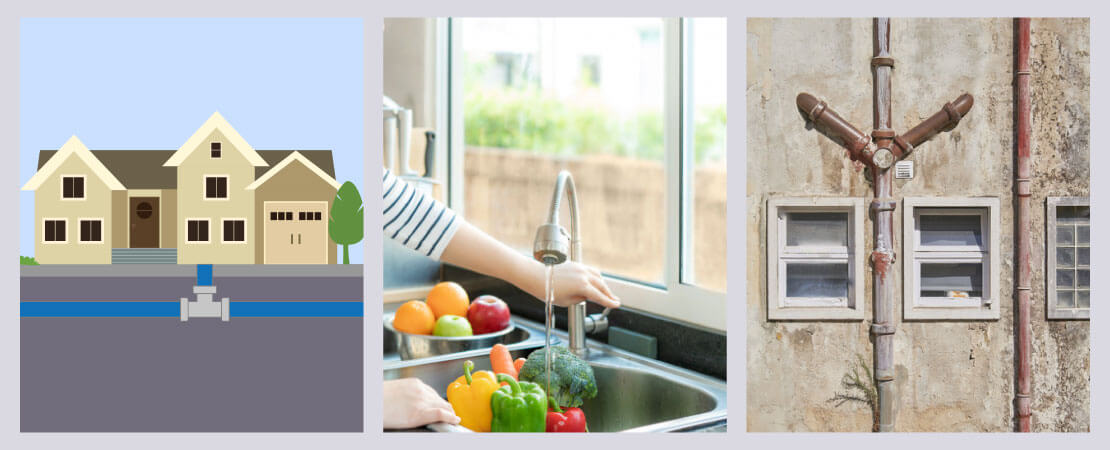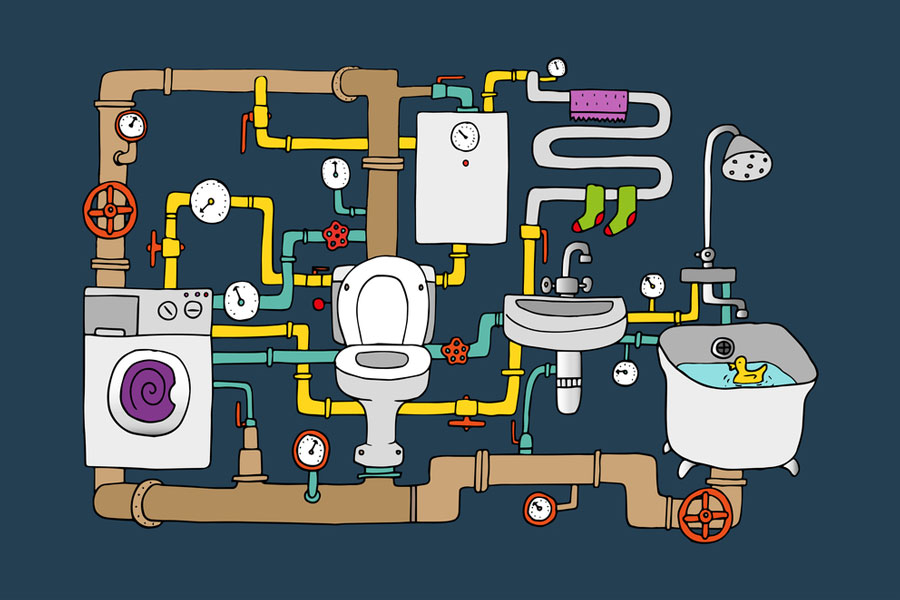Breaking Down Your House's Plumbing System Anatomy
Breaking Down Your House's Plumbing System Anatomy
Blog Article
They are making a few great pointers about Understanding Your Home's Plumbing Anatomy in general in the content which follows.

Comprehending how your home's pipes system functions is important for each home owner. From supplying tidy water for drinking, cooking, and bathing to safely eliminating wastewater, a properly maintained pipes system is essential for your family's health and wellness and comfort. In this thorough guide, we'll explore the intricate network that composes your home's plumbing and deal pointers on upkeep, upgrades, and dealing with typical problems.
Intro
Your home's plumbing system is greater than just a network of pipes; it's an intricate system that guarantees you have access to tidy water and reliable wastewater removal. Knowing its components and just how they collaborate can assist you protect against pricey repair services and guarantee everything runs efficiently.
Fundamental Components of a Pipes System
Pipelines and Tubing
At the heart of your pipes system are the pipes and tubing that lug water throughout your home. These can be made from different materials such as copper, PVC, or PEX, each with its benefits in terms of resilience and cost-effectiveness.
Components: Sinks, Toilets, Showers, etc.
Components like sinks, bathrooms, showers, and bathtubs are where water is made use of in your home. Understanding exactly how these fixtures link to the plumbing system assists in diagnosing troubles and preparing upgrades.
Shutoffs and Shut-off Points
Valves control the circulation of water in your plumbing system. Shut-off valves are crucial during emergency situations or when you require to make repairs, enabling you to separate parts of the system without disrupting water flow to the whole house.
Water Supply System
Key Water Line
The major water line connects your home to the community water or a private well. It's where water enters your home and is distributed to different components.
Water Meter and Stress Regulatory Authority
The water meter measures your water usage, while a pressure regulatory authority ensures that water moves at a secure pressure throughout your home's pipes system, stopping damages to pipelines and components.
Cold Water vs. Warm water Lines
Comprehending the distinction in between cold water lines, which provide water directly from the primary, and hot water lines, which carry heated water from the hot water heater, aids in troubleshooting and planning for upgrades.
Water drainage System
Drain Pipes Pipeline and Traps
Drain pipelines lug wastewater away from sinks, showers, and bathrooms to the sewage system or septic tank. Traps stop sewage system gases from entering your home and also catch debris that might trigger obstructions.
Air flow Pipes
Ventilation pipes allow air into the drain system, protecting against suction that could slow drainage and cause traps to empty. Appropriate air flow is crucial for maintaining the integrity of your pipes system.
Importance of Proper Drainage
Guaranteeing appropriate drain stops back-ups and water damages. Consistently cleaning drains pipes and maintaining traps can avoid pricey repairs and expand the life of your pipes system.
Water Heater
Kinds Of Water Heaters
Hot water heater can be tankless or typical tank-style. Tankless heating systems warmth water as needed, while containers keep warmed water for immediate use.
Just How Water Heaters Attach to the Pipes System
Comprehending how hot water heater connect to both the cold water supply and warm water distribution lines assists in diagnosing issues like insufficient warm water or leaks.
Maintenance Tips for Water Heaters
Routinely flushing your hot water heater to get rid of sediment, examining the temperature level settings, and examining for leaks can extend its life-span and enhance power performance.
Typical Plumbing Concerns
Leakages and Their Reasons
Leakages can happen due to aging pipelines, loosened fittings, or high water stress. Resolving leaks promptly protects against water damage and mold and mildew development.
Clogs and Blockages
Blockages in drains and commodes are commonly caused by purging non-flushable items or a build-up of grease and hair. Using drainpipe screens and bearing in mind what decreases your drains pipes can avoid obstructions.
Indications of Pipes Issues to Watch For
Low tide stress, slow drains pipes, foul odors, or uncommonly high water costs are indications of possible plumbing issues that need to be dealt with immediately.
Pipes Maintenance Tips
Routine Examinations and Checks
Schedule annual plumbing assessments to capture issues early. Search for signs of leaks, corrosion, or mineral buildup in faucets and showerheads.
Do It Yourself Upkeep Tasks
Easy tasks like cleansing faucet aerators, looking for commode leaks making use of color tablets, or protecting revealed pipes in chilly environments can prevent major pipes concerns.
When to Call a Professional Plumbing Professional
Know when a plumbing problem calls for specialist competence. Attempting intricate fixings without proper understanding can bring about even more damages and greater fixing prices.
Updating Your Pipes System
Factors for Updating
Upgrading to water-efficient fixtures or replacing old pipes can boost water quality, lower water costs, and boost the value of your home.
Modern Plumbing Technologies and Their Benefits
Discover modern technologies like smart leakage detectors, water-saving toilets, and energy-efficient hot water heater that can save money and lower ecological influence.
Expense Factors To Consider and ROI
Determine the ahead of time expenses versus long-term savings when thinking about plumbing upgrades. Numerous upgrades pay for themselves via minimized utility costs and fewer repair services.
Ecological Effect and Preservation
Water-Saving Components and Home Appliances
Setting up low-flow taps, showerheads, and commodes can significantly reduce water usage without giving up efficiency.
Tips for Lowering Water Usage
Simple habits like fixing leaks without delay, taking much shorter showers, and running complete lots of washing and recipes can save water and reduced your utility costs.
Eco-Friendly Plumbing Options
Consider sustainable pipes materials like bamboo for floor covering, which is durable and green, or recycled glass for counter tops.
Emergency Readiness
Actions to Take During a Pipes Emergency
Know where your shut-off shutoffs are located and just how to shut off the water supply in case of a ruptured pipeline or significant leakage.
Importance of Having Emergency Situation Contacts Convenient
Keep contact details for local plumbing professionals or emergency solutions easily offered for quick reaction during a pipes dilemma.
Do It Yourself Emergency Fixes (When Relevant).
Short-term repairs like using duct tape to spot a leaking pipeline or positioning a container under a dripping tap can reduce damages up until a specialist plumber shows up.
Final thought.
Comprehending the anatomy of your home's pipes system encourages you to preserve it effectively, conserving money and time on repair services. By following routine maintenance regimens and staying notified concerning modern pipes technologies, you can ensure your plumbing system operates successfully for years to find.
Exploring Your Homes Plumbing Anatomy
Water Supply System
Main Water Line: This is where water enters your home from the municipal supply or a private well.
Water Meter: Typically located near where the main water line enters the property, it measures the amount of water used.
Shutoff Valve: It s crucial to know where this is in case of emergencies. It allows you to turn off the water supply to the entire house.
Pipes and Fittings: These distribute water throughout your home. Materials can include copper, PVC, or PEX.
Drain-Waste-Vent (DWV) System
Drains: Located in sinks, showers, and tubs, these carry wastewater away.
Traps: U-shaped pipes under sinks that hold standing water, blocking sewer gases from entering the home.
Vents: Pipes that lead from the DWV system to the outside, preventing vacuum formation and allowing gases to escape.
Sewer Line: Carries all wastewater from the home to the municipal sewer system or a septic tank.
Fixtures and Appliances
Sinks, Toilets, and Showers
Dishwashers and Washing Machines
Water Heaters
Maintenance Tips
Regularly check for leaks in exposed pipes and around fixtures.
Inspect the water heater annually for signs of wear.
Clean drains and traps to prevent clogs and odors.
Know how to shut off water to individual fixtures.
When to Call a Professional
Major leaks or burst pipes
Installation of new pipes or fixtures
Septic tank issues
Remodeling projects that involve plumbing changes
Conclusion
Understanding the anatomy of your home's plumbing is key to maintaining a functional and efficient system. Regular checks and knowing when to call in the experts can save you time, money, and stress.
https://www.mavyn.com/blog/exploring-your-homes-plumbing-anatomy

Exploring Your Homes Plumbing Anatomy
Water Supply System
Drain-Waste-Vent (DWV) System
Fixtures and Appliances
Maintenance Tips
When to Call a Professional
Conclusion
Understanding the anatomy of your home's plumbing is key to maintaining a functional and efficient system. Regular checks and knowing when to call in the experts can save you time, money, and stress.
https://www.mavyn.com/blog/exploring-your-homes-plumbing-anatomy
I hope you enjoyed our piece on . Thanks so much for spending some time to browse our piece. Kindly set aside a second to share this blog if you liked it. I value reading our article about .
Get A Free Estimate Report this page